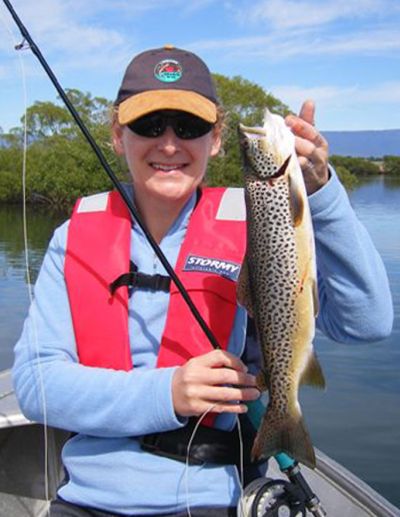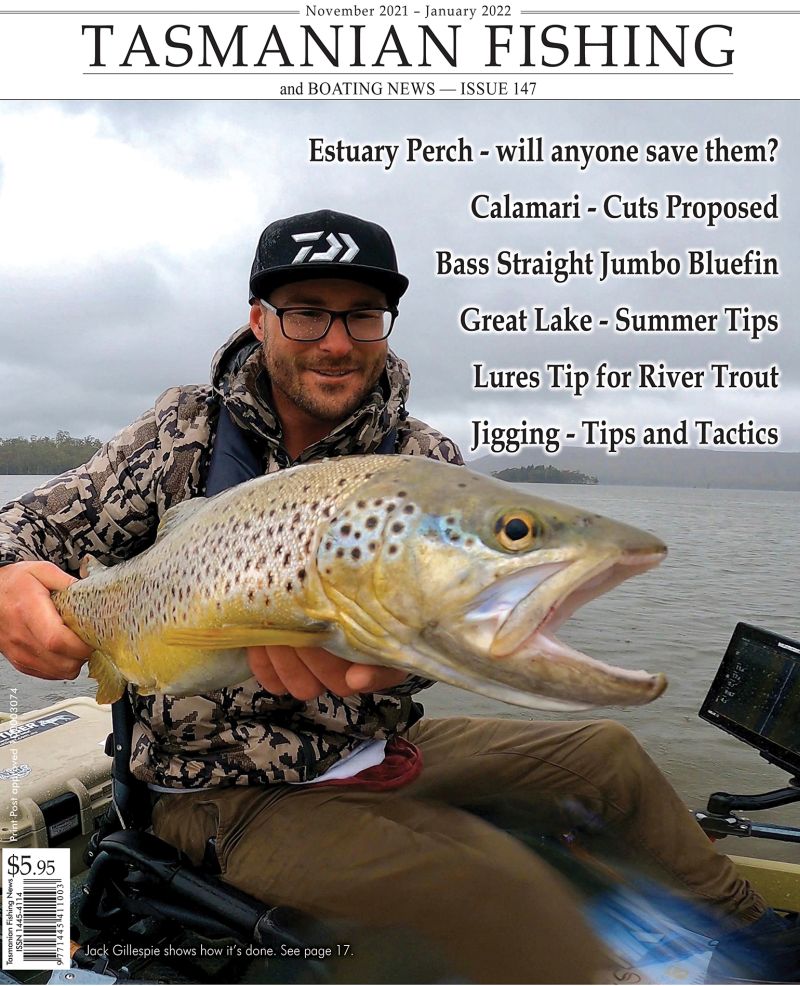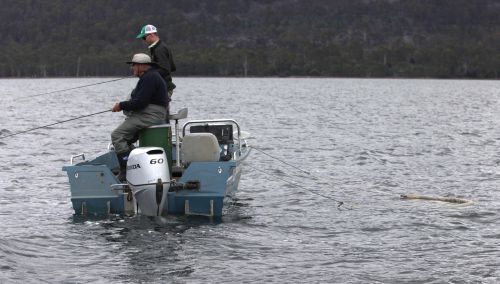From the Archives ...
Suggestions for Early Season Waters
Suggestions for Early Season Waters
by Sarah Graham
Many anglers are preparing for the opening of the new angling season on Saturday 7 August and it's shaping up to be another good one with the fishery in excellent health as a result of last year’s drought breaking rains. There are many great fishing locations around the State from which to choose for the opening weekend and early season fishing but here are a few suggestions.
Very Slow Nymphing
Todd Lambert  Spring is nearly over and as we head into what looks like being another long hot summer. I believe this season holds an anticipation amongst Tasmanian anglers not seen for quite a while thanks in large to renewed water levels in many of our impoundments due to better than average Autumn and early Spring rainfall.
Spring is nearly over and as we head into what looks like being another long hot summer. I believe this season holds an anticipation amongst Tasmanian anglers not seen for quite a while thanks in large to renewed water levels in many of our impoundments due to better than average Autumn and early Spring rainfall.
- Category: Trout Fishing
- Hits: 7022
Sea Trout Fishing - October and November
Christopher Bassano
Fishing guide Christopher Bassano explores his favourite fishing-and shares a few tips that will help you discover the world of trout near the sea.
- Category: Trout Fishing
- Hits: 16727
Trout on Plastics - It ain't always easy
Simon Little
When I first moved into Launceston to study at the Australia Maritime College, I found that the easiest way to sneak out for a quick fish was to chase trout. Consequently I researched everything I could find on trout, in Tasmania and round Australia. Baits, lures, retrieves, locations and typical dwellings, tackle and gear - the works. After extensive investigation I set-up with a light rod and spinning reel and your run-of-the-mill bibbed minnows and cobras.
- Category: Trout Fishing
- Hits: 12656
Ikijimi method of killing fish
Once you have caught your fish it is most important that you handle and care for it correctly to ensure that it does not deteriorate to the point it is wasted.
Deterioration occurs both through chemical and bacterial processes. Depending on the time taken and subsequent treatment of catch this will affect the taste and texture of meat.
All wanted fish should be killed humanely and quickly.
- Category: Trout Fishing
- Hits: 7107
Nymphing Maniac
There are probably more trout caught nymphing than with any other method during the trout season. But what exactly is meant by nymphing? What are the patterns associated with this method, and what are the best ways to fish them? In truth nymphing has as many different variations as do dry fly fishing, loch style, or just about any other style of fly fishing you would care to mention. If we were to closely examine how each individual angler goes about "nymphing", we would find many different variations on the theme. The following is a basic insight into what that theme involves.- Category: Trout Fishing
- Hits: 9878
West Coast sea trout
by Greg French
Sea trout are simply brown trout which spend time in the ocean. In spring they follow huge schools of whitebait into the estuaries and lower freshwater reaches of most of the state's rivers and creeks. Some of the best action is conveniently close to Tasmania's major population centres. Hobart has the mighty Derwent as well as the southern rivers (including the Huon, Lune and Esperance). Launceston anglers have the Tamar, North Esk and Great Forester. While on the north west coast there are a number of superb fisheries, including the Mersey, Leven, Forth, Black, Detention, Inglis and Duck.
- Category: Trout Fishing
- Hits: 11707
North East Tasmania Trouting
Jamie Henderson
The North East Coast of Tasmania is undoubtedly home to some of the states best saltwater fishing; world class game fishing, amazing estuary sports fishing and some of the best bream fishing in the country. When we talk about quality trout fishing our minds and hearts always wander to magical western lake-tailing trout, dun hatches on Little Pine and big sea run trout on the west coast. However for East Coast trout anglers there are a number of fresh water gems closer to home that offer quality trout fishing to those willing to do a little leg work and poking about. The region has it all to offer from magical stream fishing to trophy trout waters and all within 90 minutes drive from the East Coast town of St Helens.
- Category: Trout Fishing
- Hits: 17546
Early Prospects for 2009-10 Trout Fishing Season
Greg French
Since the big wet of 1996-97 Tasmania, like the rest of south-eastern Australia, has suffered from a severe lack of rain. The Midlands, East Coast and eastern fringes of the Central Plateau have been especially hard hit in the last three years, with disastrous consequences for high-profile trout fisheries like Tooms Lake, Craigbourne Dam and the Coal River. Whether this can be attributed to normal drought cycles is moot: the trend to generally drier conditions has been evident since at least the mid-1980s and may well be the result of irreversible climate change.
- Category: Trout Fishing
- Hits: 5635
Read more: Early Prospects for 2009 2010 Trout Fishing Season
Jigging for Trout
Tom Crawford takes a slightly different approach to lure fishing for trout.Vertical jigging is becoming very popular in salt water fishing in Tasmania with the release of many large and sophisticated jig's hitting the market. But very few people try this method for trout. One of the biggest problem trout fisherman face is getting their lure or fly down to where the fish are sitting. This technique cures that problem. Jigging for trout has been extremely popular in New Zealand for quite some time and has produced many good sized fish there. In this article I will give you a look into what I believe should be one of the more popular fishing techniques in Tasmania in years to come.
- Category: Trout Fishing
- Hits: 8353
Slow down and give the Winter trout waters a try
Leroy Tirant gets beaten by his son and learns a Winter lesson.There have been many articles over time about fishing in winter. I love targeting Tasmania's fish rich lakes on clear crisp winter days, perhaps almost romanticising it, because it's quite easy once home and warm to forget how really cold it was-and how hard it was to finally find feeding fish. These can be swimming lethargically in 30 feet of water.
Most of my fishing is done from a boat, but occasionally and it seems only in winter, my young bloke and I will wander around the shoreline, mainly for his sake more than mine because he loves discovering things. At five years of age he competently fishes on his own with little instruction from his dad. As with most youngsters though he can become annoyed if he thinks I'm taking over.
- Category: Trout Fishing
- Hits: 5520
Current TFBN
Click above for current issue content. The current issue of TFBN is extensive and topical. In Tackle Stores, Newsagents and by subscription.
Delivered to your door for $48 for 2 years (8 issues). To subscribe, send Mike $48 via www.paypal.com.au . (Basic instructions are here) The email is at Contact Us. Your address will be included from PayPal.
Or phone Mike with your c/c handy on 0418129949
Please ensure your details are correct, for Mike to organise delivery.
TFBN Newsletter Sign up Form
Why not submit an article ?
When you have finished for the day, why not have a brag about the ones that didn't get away! Send Mike an article on your fishing (Click here for contact details), and we'll get it published here. Have fun fishing - tasfish.com
Category Descriptions
Here is a list of all of the Article Categories. The number in Brackets, eg (13) is the number of articles. Click on Derwent River and all articles relating to the Derwent will be displayed in the central area.
Articles by Category
-
Rivers (3)
-
Saltwater and Estuary Fishing (149)
-
Kayak Fishing (34)
-
Lakes (1)
-
Great Lake (62)
-
Lake Leake (52)
-
Woods Lake (16)
-
Lake Augusta (11)
-
Huntsman Lake (13)
-
Lake Pedder and Gordon (10)
-
Lake Dulverton (5)
-
Lake Crescent (6)
-
Tooms Lake (10)
-
Lake Mackintosh (2)
-
Lake Barrington (5)
-
Little Lake (8)
-
Meadowbank Lake (5)
-
Lake King William (7)
-
Lake St Clair (2)
-
Western Lakes (12)
-
Arthurs Lake (35)
-
Lake Echo (7)
-
Four Springs (54)
-
Lake Sorell (7)
-
Lake Burbury (6)
-
Other Lakes (57)
-
Brushy Lagoon (18)
-
Little Pine Lagoon (5)
-
Penstock Lagoon (16)
-
Brumbys Creek (7)
-
-
Events (48)
-
Estuary Fishing (0)
-
Coastal Catches (46)
-
Super Trawler (46)
-
IFS, DPIPWE, MAST and Peak Bodies (435)
-
Commercial Interests (98)
-
Other (24)
-
TFBN Back Issues (8)
-
Fly Fishing (67)
-
Trout Fishing (250)
-
Meteorology and Weather (8)
-
Jan’s Flies (50)
-
Tuna Fishing and other Game Fishing (86)
-
Cooking Fish (19)
-
Fishing Information (1)
-
Fishing Books (8)
-
Videos (5)
-
Tackle, Boats and other Equipment (146)
-
World Fly Fishing Championship 2019 (2)
Popular Tags
windyty.com
Visit https://www.windyty.com/
Rubicon Web and Technology Training
Hello everyone, I thought it would be a good time to introduce myself.
My name is Stephen Smith and I have been managing the website tasfish.com since May 2009.
It has been an epic journey of learning and discovery and I am indebted to Mike Stevens for his help, support and patience.
I am developing a new venture Rubicon Web and Technology Training ( www.rwtt.com.au ). The focus is two part, to develop websites for individuals and small business and to train people to effectively use technology in their everyday lives.
Please contact me via www.rwtt.com.au/contact-me/ for further information - Stephen Smith.
From the Archives ... (last chance)
Trout tips - from tackle shops
Presented from Issue 105, August 2013
We did a bit of a runaround Tasmania’s tackle stores to see what their tips for the first month or so of the tackle season were. We asked what the top three places to fish were, plus lures, flies, baits and a few other things.
Here is a rundown on their answers Whenever, and wherever you fish - anywhere, or for any fish in the world - ask the locals and especially ask at the local tackle store. They know what was caught today, yesterday and on what.



